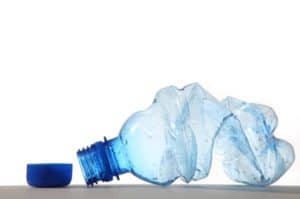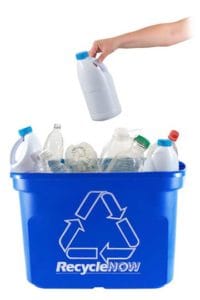Is plastic bottles recycling better or does landfilling them have an overall lower carbon footprint? If you live in a place where mandatory curbside collection exists, you may think this is a funny or maybe even absurd question. Yet, I recently came across a study that goes deeper into the problem and helps us question whether all that shines is gold.
Scroll down to watch two great videos as well.
Eric Johnson, Director of Atlantic Consulting in Switzerland, recently completed an independent research. “PET’s carbon footprint – to recycle or not to recycle” aims to address users and producers of PET as well as regulators and policy makers.
According to the study, for regions with adequate space and little recycling infrastructure, disposing of bottles in landfill generates a lower carbon footprint than recycling or incineration. The ever-present PET bottle, the one for packaging drinks, we may best bury after use rather than burn or reconvert into a second-life product. According to the study, the footprint of recycling is lower than that of landfills only if at least half of the plastic ends up being valorised.
That’s right: only if about 50% or more of the used PET actually displaces production of new PET, will recycling deliver the lowest footprint. In recycling programs using curbside collection, typically less than 50% of the used bottles end up displacing new PET. Programs using take-back obligations, separate collection or bottle-deposits, however, tend to report much higher displacement rates. Some in the range of 75%!
How about incineration then? Charging used plastic bottles to waste incinerators converts them largely to carbon dioxide (greenhouse-gas), which then goes straight into the atmosphere. This footprint debit can partially decrease by generating power and heat from the incinerator. Yet, waste incinerators even at their best are inefficient power generators, so the net effect is still far more ‘carbon positive’ than either recycling or landfilling.
What the study suggests are two important points for policy makers.
One, in regions that already have a recycling infrastructure, the low-carbon aim should be to boost used PET’s displacement of new PET significantly above 50%. The key is not in raising curbside collection rates, but in improving yields. Especially in sorting and to a lesser extent in reprocessing. It is a no-brainer.
Collecting clean, as pure as possible used-material yield a much cleaner recyclate than collecting heaps of mixed materials. The technology for cleaning and sorting plastics is rather poor and unlikely to improve dramatically. So the fix must be in collection. Hence, wash your plastic products before you toss them into the recycling bin.
Second, in regions or countries without a recycling infrastructure whatsoever, the lowest-carbon choice may well be to landfill plastic bottles. Happily for them, it is the cheapest choice as well. That is the case in the UAE as well where waste tax does not exist. Call it ‘carbon capture and storage’ if you will, on an economy budget. And the carbon really is stored: degradation of plastics in landfill, even under wet conditions, is very minor.
There are two other significant points: one is the correction of a misperceived conventional wisdom. Habitually we have heard that the practice of shipping baled plastic bottles to China for recycling is an ecological nonsense. That it overrides the benefits of valorisation.
Not true, says the study. Sure, the transport adds to the footprint, but not nearly as certainly as displacement. If the travelling bottles end up substituting what would have been new PET, then the journey was well worthwhile.
The study found that PET recyclate has a lower carbon footprint than virgin PET. Manufacturers making product from recycled PET should be able to claim that they are lower-carbon than alternatives made from new PET. For the record, recycled PET products could be straps, films and fibres (for fleeces and similar garments). Hopefully governments or consumer groups could help out by awarding such products low-carbon labels.
The idea from the study is clear:
- push your government to establish a solid network of recycling centers and
- make sure you collect and give away all your plastic bottles for recycling.
- More importantly though, make sure recycling is obligatory at is it only then that solid quantities are amassed.
Segregate your recyclable waste at source. Clean it before you throw it away.
Now, there is an essential caveat – we should actually minimize our consumption of bottled water and waste overall.
Credit: Excerpts from Eric Johnson’s “Landfill could be greener than recycling when it comes to plastic bottles“, The Ecologist
Check out our articles on Plastic Recycling in Taiwan – Green Gold, Plastic Bag Usage, Plastic Infographic – How to Reduce Plastic Usage, Tackling Electronic Waste











what is PET polyethylene terephthalate, polyethylene terephthalate, is the most common thermoplastic polymer resin of the polyester family and is used in fibers for clothing
You can publish our comments if you also think it worthwhile.
The use of PET in bottles should be restricted to carbonated drinks/beverages only! PET is too restrictive in terms of second life products which can be produced from PET.
All still water, juices and milk type products should all be packed in the Polyethylene family of plastic – same as what safe and proven Tupperware is made from.
Why ? Because post consumer polyethylene plastics are much easier to recycle than PET and there are a multitude of timber replacement applications suitable for composite polyethylene plastic – this has the added advantage of reducing our dependence on cutting down trees for lumber, trees that have the critical job of filtering our environment/atmosphere. Please select the best and most appropriate plastic type when designing your packaging.